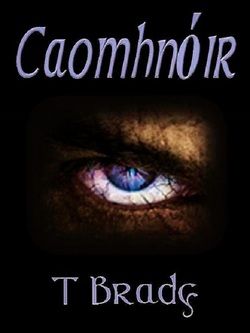|
In this post: Book Details, My Review, Author Hot Seat Book Details: Caomhnoir Puck, a demon composed of dark matter, is the collective consciousness of evil and feasts on the death and destruction borne of warfare as he effortlessly manipulates the most potent weapon ever created: the human mind. The task of killing this evil antagonist rests on the shoulders of a solitary, mortal man; Neil Branch, the Caomhnóir. Branch naively considers himself to be an ordinary man with an extraordinary problem. He recklessly discounts his purpose and is in perpetual conflict with his destiny. Puck continuously assaults Branch within the realm of the subconscious and twists his dreams into surreal, insidious nightmares that forecast the demise of all that he holds sacred, but the visions also reveal the demons intent and expose clues that may lead to the beast’s downfall. Desperate, and driven to the brink of madness, Branch must resolve his emotional turmoil, accept his loses, and acknowledge his faults and frailties as he summons the courage to fight for the possession of his soul and deliver humanity from eternal bondage. See it here: Amazon / GoodreadsMy Review: Andy McNab meets Stephen King in this firestorm of demonic action and suspense. I'll be honest with you, when I read the title of this book I thought I'd be reading some heavy, archaic prose right out of the dark ages. I was SO wrong about that and I implore you all not to judge this book at first glance. Pick it up and start reading, because as soon as you do, you'll be bowled over by a gritty, realistic soldier's narrative that twists its plot superbly to a range of modern historic times and places. The prose is literary but not overdone and makes for a rich but quick-paced read. The supernatural elements to the tale were what initially drew me in, but as the story progressed I really became invested in Neil, George, John and Sean as characters and by the end of the novel it was their lives that had me captivated rather than the unholy chaos going on around them. Puck was a well crafted villain and the visions that Neil experiences during the novel are vivid and truly horrific. I'm not usually a fan of starting in the middle of the narrative and jumping back into backstory, but this writer knows how to deliver a timeline of events with poise and precision. Overall this book is highly recommended for those who enjoy military fiction and sci-fi/fantasy tales, but in all honesty I think that anyone with a strong stomach and a thirst for high-impact adventure will thoroughly enjoy it too. Overall Reaction: 5 STARSThe Hot Seat: Five Burning Questions Answered by T. Brady  1) What experiences in your own life influenced the decision to set the caomhnoir legend amid the world of the military? I have always had a fascination with history, military history in particular. As far as Caomhnoir is concerned, it originated from an article that I had read about the My Lai village massacre during the Vietnam war. U.S. soldiers killed over three hundred men, women and children without provocation. I began to think, “what would cause these men to commit such a heinous act?” and then my imagination took over. “What if these events were orchestrated by some sort of supernatural phenomena, a force of evil that could manipulate the human mind?” 2) How long did it take you to write this novel and what was that experience like for you? The original story was written in 2001 as a screenplay titled “The Antagonist.” Through several edits and rewrites, the final work was well reviewed and recommended by a script writing service, but I had no takers. Although I went on to write over a dozen screenplays, this tale kept haunting me. I felt as if I had left Branch in lurch, his story was not fully realized. So in 2005 I began working on converting the screenplay into a novel. I wrote while working fulltime and raising a family, so it was a long process. I had actually put it aside a few times for extended periods. The hours of editing, revision, and fact checking became a bit overwhelming at times as the story evolved and took on a life of its own, but I had to see it through. I have learned that this process is unavoidable, especially for a first time novelist, and will determine if you have the stamina and perseverance to write; regardless if you are monetarily successful or not. 3) In my imagination, your villain Puck looked like a young Ian McKellen straight out of Macbeth. Who do you picture when you see his face in your head? Jeremy Irons comes to mind when I think of Puck, in his middle aged years, not now (pictured above). 4) None of the relationships between the soldiers and their wives went very well in your novel. Was it a conscious decision to represent military men and their guarded emotions in this way? I tried to stay true to the mind set, attitudes, and social norms of the day. Men were very reserved in this time period, so I just amplified that with Branch and Meadows. Each man is emotionally wounded and scarred, although their experiences differ, they did not have a consistent or dependable male role model. The very act of war is very damaging to a person’s emotional state, which affects each man’s ability to connect with others who are outside of their realm of experience, and in Branch’s case this is magnified by his designation as Caomhnoir. 5) What's next for you as a writer? Do you have more books planned? I am currently working on a prequel to Caomhnoir, which delves into the origins of Puck and the Caomhnoir order. I have many ideas on the table, I feel that a few of my screenplays would translate well into novels, so I’ll just keep pecking away.
0 Comments
Leave a Reply. |

 RSS Feed
RSS Feed
